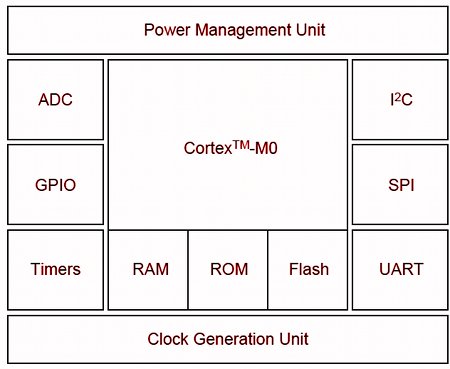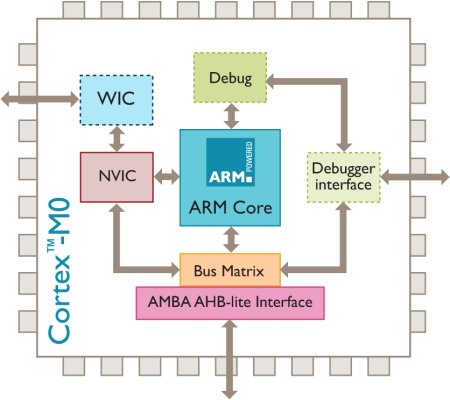“Smallest, lowest-power” ARM core debuts
Mar 25, 2009 — by Eric Brown — from the LinuxDevices Archive — 59 viewsARM has announced a “Cortex-M0” core that is billed as being the smallest, lowest-power ARM processor yet. The heir to the Cortex-M3 will debut in NXP's LPC1100-series microcontrollers, due to ship in early 2010 for e-metering, consumer electronics peripherals, remote sensors, and other low-powered or battery-powered applications.
NXP says it will demonstrate the first functional silicon based on ARM's new Cortex-M0 at next week's Embedded Systems Conference in Silicon Valley. The Cortex-M0 offers breakthroughs in size, code density, and energy efficiency, while also offering a simple architecture that eases development, according to NXP.

A block diagram of NXP's LPC1100
Source: NXP
(Click to enlarge)
The LPC1100 (block diagram, above) will include not only the Cortex-M0 core — see below for further details — but also up to 128KB of flash memory, and up to 16KB of SRAM, says NXP. The device also includes a UART, an SPI controller, an I2C bus interface, up to 42 GPIOs, a watchdog timer, and a 10-bit A2D (analog-to-digital) converter, the company says.
Touted as having “32-bit performance combined with multiple power modes and very low deep sleep power,” the LPC1100 is claimed to have “industry-leading” energy efficiency. NXP adds that the device will be available in 48-pin LQFP (low profile quad flat package) or 33-pin HVQFN (heatsink very-thin quad flat-pack no-leads) versions, though we didn't see any dimensions specified.
The Cortex-M0
Building on ARM's Thumb instruction set, and its later Thumb-2 technology, which formed the basis of the circa-2004 Cortex-M3, the Cortex-M0 processor is touted as offering 32-bit performance in a 16-bit footprint. Comprised of a miniscule processing core, system, and memories (see diagram below), the chip delivers a claimed 0.9 DMIPS/MHz while consuming as little as 0.085 milliwatts in an area of under 12K gates. It is also said to retain tool and binary compatibility with the Cortex-M3.

Cortex-M0 block diagram
(Click to enlarge)
The Cortex-M0 is aimed at a wide variety of analog mixed signal applications, as well as ultra low-power MCU, and even system-on-chip (SoC) applications, says ARM. Specific applications include:
- Medical devices
- E-metering
- Lighting
- Smart control
- Analog and mixed signal sensors and actuators
- Gaming accessories
- Power control
- Motor control
- IEEE 802.15.4 (ZigBee) and Z-Wave systems
Development features and benefits of the M0 are said to include:
- Ultra low power consumption and integrated sleep modes for longer battery life
- Thumb instruction set for maximum code density
- Fast interrupt handling for critical control applications
- Wake-up Interrupt Controller for ultra low leakage retention and instantaneous fully-active mode
- Enhanced system debug
- 100 percent C coding, including interrupt handlers and boot code
- Zero assembler code required
The Cortex-M0 is able to achieve low power consumption in part due to the ARM Ultra High Density Standard Cell Library and ARM Power Management Kit (PMK), says the company. These IP technologies are said to be available for low-power memory instances built specially for Cortex-M0, called 180ULL processes.
The ARM 180ULL libraries are optimized for high-density, low-power applications, enabling low dynamic and static power consumption and minimizing chip area, says ARM. The PMK is also said to provide dynamic and leakage power management functions, according to the company.
Development tools
Tools support for the Cortex-M0 is offered by way of the Keil MDK-ARM Microcontroller Development Kit from ARM subsidiary Keil. The kit integrates ARM RealView Compilation Tools with the new Keil µVision4 IDE (integrated development environment) and Debugger. ARM says that the processor is “also supported by third-party tool and RTOS vendors,” but provides no further details.
ARM also provides an ARM Microprocessor Prototyping System (MPS), which is said to integrate either the Cortex-M3 or Cortex-M0 processor operating at up to 50MHz together with an Altera Stratix III (EP3SL50) FPGA (field-programmable gate array) for system prototyping. The development board is said to offer CAN, FlexRay, RS232, DVI, USB, Ethernet, Audio, and MMC interfaces, as well as “free synthesis,” and a Place and Route tool. An example AMBA AHB system is included for developing third-party IP for a Cortex-M0 device, and the kit ships with the Keil MDK-ARM kit (evaluation version), as well as a Keil ULINK2 USB-JTAG adapter.
A growing Cortex family
The Cortex-M0 processor is said to be compatible with the new Cortex Microcontroller Software Interface Standard (CMSIS) vendor-independent hardware abstraction layer for Cortex-M processors, which include the M3 and M1 chips. Other Cortex-family series include the Cortex-R4, aimed at microcontrollers used in real-time applications such as automotive braking systems.
Recently, the most influential of the Cortex processors in the embedded world has been the Cortex-A8, a superscalar processor core that shipped in 2005. The Cortex-A8 is incorporated in the Texas Instruments (TI) OMAP3 SoC family, and newer Freescale i.MX51x SoC family, both of which are aimed primarily at multimedia-ready consumer electronics devices, and even netbooks.
In 2007, ARM shipped a multicore version of the Cortex-A8 called the Cortex-A9, which will drive TI's recently announced OMAP4 platform. The A9 adds ARM's MPCore interconnect layer, for support of up to four cores. However, the initial OMAP4 chips will incorporate only two ARM cores, each clocked “above 1GHz,” according to TI.
Stated Geoff Lees, VP and GM, Microcontroller Division, NXP Semiconductors. “The Cortex-M0 processor takes the complexity out of using 32-bit processors. Customers can take full advantage of their existing ARM tool chains and preserve their software investment.”
Mike Inglis, EVP and general manager of ARM's processors division, said, “The introduction of the first Cortex-M0 processor silicon, just weeks after its public release, is a fantastic achievement by NXP.”
Availability
The first Cortex-M0-based microcontroller, NXP's LPC1100, should be widely available in early 2010, says NXP. For more information, see the company's website, here.
More information on the Cortex-M0 may be found here.
This article was originally published on LinuxDevices.com and has been donated to the open source community by QuinStreet Inc. Please visit LinuxToday.com for up-to-date news and articles about Linux and open source.